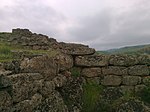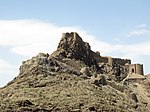Building in the west of Tappe
According to the plan of the discovered building and according to the archaeological and architectural investigations, the building was built before Apadana. The entrance of the building is in its eastern side like a central temple. It has two connected spaces. [1]
The inner space of the building is rectangular and its entrance is in the neighboring room. The rest of a coal bowl in the southern side of the main room proves, that the fire ceremony was carried out (secretly). It can be suggested that the first fire temple was in a covered space in Noushijan Tappe and the ceremony had a connection with the developing religious ceremony in the median era. On the southern and western wall, there are ruins of two niches with egg-shaped vaults. [1]
This page is based on this
Wikipedia article Text is available under the
CC BY-SA 4.0 license; additional terms may apply.
Images, videos and audio are available under their respective licenses.





















